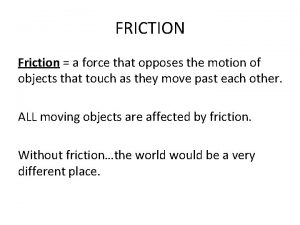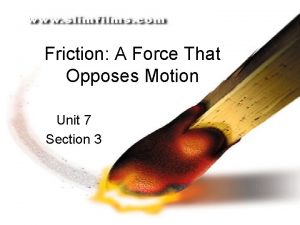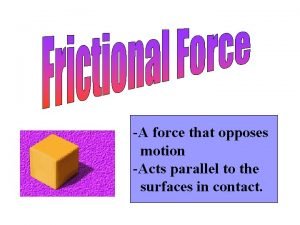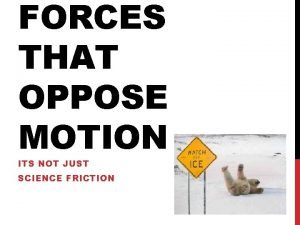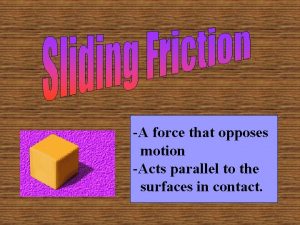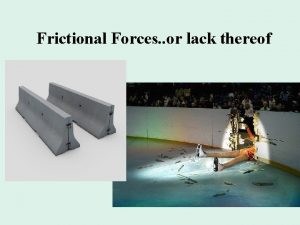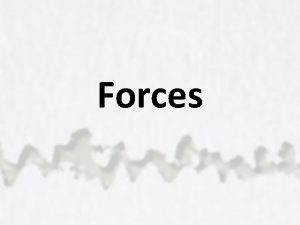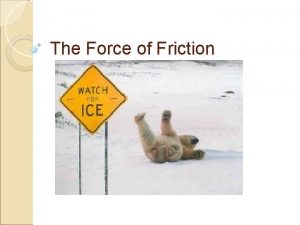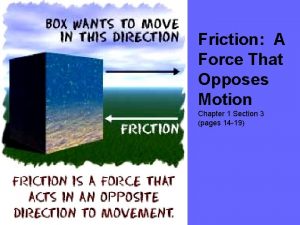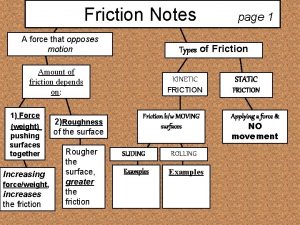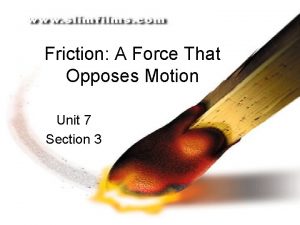Friction Definition the force that opposes the motion













- Slides: 13

Friction Definition: the force that opposes the motion of one surface past another Dependent upon: 1) type of material 2) how tightly pressed they are together (more weight =more friction) It’s time to experience friction, so rub your hands together.

Characteristics of friction 1) ALWAYS opposes motion a) it will slow it b) or prevent it from moving 2) Creates heat 3) Symbol is lowercase ‘f’…Ff

2 types of friction Static 1) prevents motion from starting. 2) occurs before motion Which is bigger…static or kinetic? Kinetic friction 1) slows objects down. 2) occurs during motion It is easier to keep an object moving than start it from rest

Static and Kinetic Frictional Forces Static Frictional Force: Reaction force to anything trying to start motion. Equal and opposite to applied force, until reaches maximum value and motion starts. friction “breaks” when F is great enough and motion begins.

Static and Kinetic Frictional Forces Static Frictional Force Breaks at a certain value: fs = s F N fs = force of static friction s = coefficient of static friction FN = Normal force s is a given value. It depends on the object and the surface.

Static and Kinetic Frictional Forces Static Frictional Force: fs = force of static friction s = coefficient of static friction FN = Normal force (usually weight) Normal force is usually just the weight of the object. FN = Mass* 9. 80 m/s 2 IMPORTANT!!!!! If the surface is not horizontal use trig. Multiply by cos of the angle of incline.

New Symbol • μ – Greek letter “Mu” • Coefficient of friction. – μs – coefficient of static friction – μk – coefficient of kinetic friction – depends on materials used and their surface conditions • Coefficient of friction: Decimal between 0. 0 and 1. 0, unitless. • Formula for solving friction: F f = μ FN

Notes on friction Almost always: μ s > μk It is easier to keep an object moving than it is to start from rest. Think about pushing a car. Both are almost always less than 1. If it was greater than one, it would be easier to pick the object up and carry it than it would be to push it across the flat surface (something like velcro)

Sand is often placed on an icy road because the sand: Decreases the coefficient of friction between the tires of a car and the road Increases the coefficient of friction between the tires of a car and the road Decrease the gravitational force on a car Increases the normal force of a car on the road

A 24 kg crate initially at rest on a horizontal floor requires a 75 N horizontal force to set it in motion. Find the coefficient of static friction between the crate and floor.

Once the crate is in motion, a horizontal force of 53 N keeps it moving with constant velocity. Find the coefficient of kinetic friction between the crate and floor.

A 55 kg baseball player slides into third base with an initial speed of 4. 6 m/s. If the coefficient of kinetic friction between the player and the ground is 0. 46, what is the player’s acceleration? How far did he slide?

Where does this apply? To car tires in accidents. By measuring the length of skid marks, police can calculate the speed a car was going before an accident.
 A force that opposes motion of a projectile
A force that opposes motion of a projectile A force that opposes motion of a projectile
A force that opposes motion of a projectile Force that opposes motion
Force that opposes motion Opposes motion
Opposes motion What is a force that opposes motion through direct contact
What is a force that opposes motion through direct contact A 925 n crate is being pulled
A 925 n crate is being pulled What is force
What is force Where do you need high friction when climbing
Where do you need high friction when climbing Lack of friction
Lack of friction Ngoại tâm thu thất chùm đôi
Ngoại tâm thu thất chùm đôi Block av độ 2
Block av độ 2 Thể thơ truyền thống
Thể thơ truyền thống Thơ thất ngôn tứ tuyệt đường luật
Thơ thất ngôn tứ tuyệt đường luật Chiến lược kinh doanh quốc tế của walmart
Chiến lược kinh doanh quốc tế của walmart
